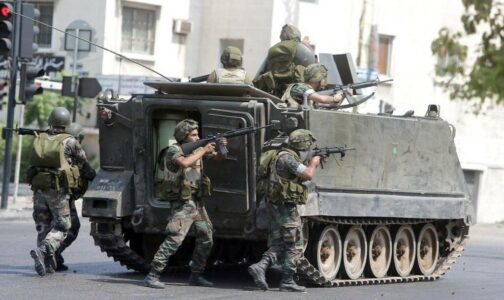
Israel faces terror threats from all angles
The recent incident in northern Israel where an explosive device was detonated near Megiddo junction on Route 65 raises many questions. According to official reports, Israel’s security forces stopped a vehicle near Moshav Ya’ara on Route 899 and there was a terrorist and a driver inside. The terrorist posed a threat and was “neutralized.” He was in possession of weapons and an “explosive belt.”
This raises key questions about various security threats to Israel and also the Iranian-backed axis of groups that threaten the Jewish state. It also is a reminder of the kind of complex asymmetric threats that Israel faces – instead of large-scale complex terror attacks, Israel increasingly faces numerous disjointed groups, from the clashes in Jenin and Nablus, to Jericho.
Pro-Iran media waited until the details of the incident in the North were revealed in Israel to discuss the story. This appears to point to the fact that Hezbollah and the pro-Iran groups are not taking credit for the incident and did not try to publicize it. These media, such as Al-Mayadeen, could have been discussing this all week, but they were not.
Israel’s assessment is that the terrorist crossed the border from Lebanon. “The terrorist stopped a vehicle and asked the driver for a ride up North,” the IDF said. “The terror attack is under extensive review, in which the possibility of the involvement of the Hezbollah terrorist army is also under review.”
The involvement of Hezbollah would be a serious escalation. But why would the terrorist group send one man with an improvised explosive device (IED), a rifle and a handgun over the border to conduct an attack of this nature? This is a major risk for the organization.
The attack doesn’t appear to be well planned or thought out. Why risk uncovering the role of Hezbollah by sending a sophisticated type of IED that can be traced to Iranian-backed groups?
Explosive types matter. The Palestinian terror groups once used bombs, including having suicide bombers target buses, to spread terror. Iran has a key role in certain types of explosive devices. It supplied Iraqi groups with Explosively Formed Projectiles (EFPs), a lethal type of IED that killed many US troops in 2006-2007.
Hezbollah has used explosives to target Israeli forces for many years and has sent operatives to train in the use of systems like EFPs. Hezbollah not only supplied Iraqi militias but this technology also ended up with the Iran-backed Houthis in Yemen. That doesn’t mean the attack in the North used this technology; it just means that explosive technology often travels through channels and networks and can be linked to various groups. So can the weapons the suspect carried.
Hezbollah has continued to threaten Israel over the years. It has harassed the Jewish state with drones and sent agents to areas near the Golan. Tensions have ebbed and flowed between the two adversaries.
A new maritime deal signed last year was supposed to reduce tensions. The new deal between Iran and Saudi Arabia might also mean reduced tensions in Lebanon in the run-up to the decision on a new president there.
So why would Hezbollah risk raising tensions with a terrorist incident like this, involving just one man? Has it frequently used explosive belts, or is this a tactic more common among Hamas, jihadists or ISIS types? These are key questions.
In the wake of the attack in the North and the “neutralization” of the suspect, many aspects of the threat lack clarity. Since it is not clear if he was affiliated with Hezbollah, it leaves the option open that he may have been affiliated with other groups. Iran backs Hezbollah, but it also backs Hamas and Islamic Jihad.
Israel has been increasingly clashing with Islamic Jihad in Jenin and also Hamas members in Jericho, as well as other armed groups in the West Bank. Iran has an interest in supporting those groups and also threatening Israel from many directions. Tehran’s interest is in making Israelis feel less secure. That means that it may try various means to threaten Israel.
It also means other groups may be actively involved. During the 2021 conflict between Israel and Hamas, there were also incidents in Lebanon of attempted attacks, including rockets fired at the Jewish state and a drone launched from Iraq.
This follows the 2018 incident in which an Iranian drone was flown from T-4 base in Syria toward the West Bank. It was downed by Israel near Beit She’an. The drone had munitions on it and may have been transporting them to groups in the West Bank.
There are other types of incidents as well. In November, two explosive devices were detonated in Jerusalem, one of them at a bus stop and another near Ramot. A suspect was eventually arrested in east Jerusalem who was believed to be an alleged ISIS supporter. There have been other incidents involving suspects who are not clearly affiliated with the usual suspects, such as Hamas or Jihad.
Iranian media these days is more interested in stories about the Iran-Saudi deal and their belief that the US and Israel are losing out in the region. In addition, Syrian regime leader Bashar Assad was in Russia to meet President Vladimir Putin on Wednesday, as the news broke about the incident in the North. Would Iran, focused on large issues of diplomacy, want to stir up an incident with Israel involving a lone gunman with an IED?
These are the questions. The overall context is that it is one of the kinds of threats Israel faces, which do not include large terror armies but rather a series of smaller groups and incidents.
Source: jpost





